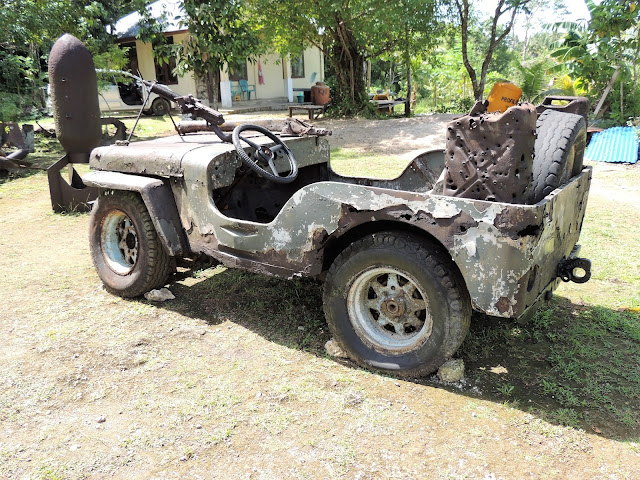Yes indeed, we are back! After a year in Micronesia, it is good to be home--although a bit disorienting. It will take some time to just decompress and realize where we are.
As a final post, we had promised to provide a bit of detail on the long and circuitous route home. Given where we wanted to go and just the sheer distance around the world, we spent an inordinate amount of time in airports and on planes. That said, it was a small price to pay for all that we experienced.
Although not far as the crow flies, the island of Biak was difficult to get to from Pohnpei. In our case, it meant a couple of days traveling from Pohnpei to Chuuk to Guam to Hong Kong to Jakarta to Sultan Hasanuddin to Biak—a classic example of “you can’t get there from here.” Nor did Biak have much going for it as a typical tourist destination. It was, however, of real interest to Roger, especially given the opportunity to see and experience some of the places his Dad wrote about while stationed there during WWII. We were able to find a local person who had lived on the island for the last 70 years and who was willing to take us around to the places we wanted to see. We visited the harbor where Dad worked supplying warships, the caves the Japanese soldiers defended until their death, and some coastal villages that Dad wrote about where he bartered for shells with the indigenous people. Seventy years and far different circumstances separated our times on Biak, but for Roger, an incredible opportunity to connect with his Dad over time and distance.

 |
| An open-air museum of sorts containing WWII artifacts. Located near the Japanese caves. |

 |
| One entrance to the Japanese caves. |
 |
| Coastal area where Dad traded for shells. |
 |
| The Village of Seba, mentioned by Dad. Fishing boats haven't changed much. |
Another day or two on planes and an overnight in Singapore got us to Siem Reap in Cambodia. The temples of Angkor deserve their status as a UNESCO World Heritage Site. The Khmer Empire, which flourished from the 9th to 15th centuries left some incredible temples in varying states of repair/disrepair. This is where we would have benefited from a much greater understanding of both Hindu and Buddhist religions and culture. We were fortunate to have a guide with knowledge of both. Along with a couple of days spent among the ruins we enjoyed a morning spent on Cambodia’s Tonle Sap, a huge lake upon which there are floating villages. We also experienced a Buddhist blessing, which was just plain bizarre—and very wet.
The hotel was excellent—with luxuries far removed from our year in the Peace Corps. Our only complaints were basically beyond anyone's control. Siem Reap's current reason for being is simply tourism, and wherever we went there were multitudes doing the same. Typical of a tourist destination, there were tacky market places full of Buddha statues and t-shirts. On the other hand, there were some wonderful restaurants, high-end shops, museums, and tuk-tuks to get you wherever you wanted to go. Even compared to Pohnpei, the heat was oppressive--95 degree temperatures and high humidity.
 |
| Angkor Wat at dawn |
 |
| Angkor Thom |
 |
| Ta Prohm where Tomb Raiders was filmed. |
 |
| Floating village on Tonle Sap |

 |
| A traditional Buddhist blessing ceremony--not what we expected. |
 |
| Tuk-Tuk travel |
 |
| Our hotel--a bit of luxury after the Peace Corps |
Following a long day traveling via Bangkok, Doha, and Casablanca, we landed in Marrakesh. We stayed in a fabulous Riad, a traditional Moroccan palace with an interior courtyard that was located only a short distance from the Medina, the walled center of the old city. Marrakesh lived up to our expectations. We had an excellent guide who took us around the Medina and showed us many areas of historical and cultural interest. Being a Muslim, he was also a great source of information on all that we were seeing in this part of the world. The market area of Marrakesh, with its hundreds of souks containing all sorts of items for sale, was also a highlight. Again, our guide was knowledgeable and took care to introduce us to merchants who had whatever we were inclined to buy. If interested in Moroccan carpets, leather, spices, clothing, silver, jewelry, etc. this was the place to go--all in all, a bit overwhelming.
 |
| The Koutoubia Minaret--tallest structure in Marrakesh |
 |
| One of the gates into the Medina |

 |
| One of many interesting faces |
 |
| Doors within doors were a common architectural feature. |
Our two days in the Atlas Mountains were the best. From donkeys carrying our packs to our hotel to an outstanding trek through the countryside, this area was spectacular both in terms of scenery and experience. The Berber villages we trekked through took us back centuries, albeit with elements of modern day irrigation systems and environmental planning. The whole ambiance of the hotel and the small Berber village of Imill reminded Roger of his European hostel tour nearly 50 years ago; for Lin the Atlas Mountains served as a welcomed harbinger of home in the Adirondacks.
 |
| Tagine cuisine--Moroccan cooking |
 |
| A group of goats provided lunchtime entertainment |
 |
| Our guide demonstrating the traditional way of serving tea. |


In short, an amazing couple of weeks that capped an incredible year-long experience serving in the Peace Corps. That said, nothing beats arriving back home and reconnecting with family and friends. Our thanks to all of you who have expressed interest in all of this. Your support has been very much appreciated. That’s pretty much it…!




























